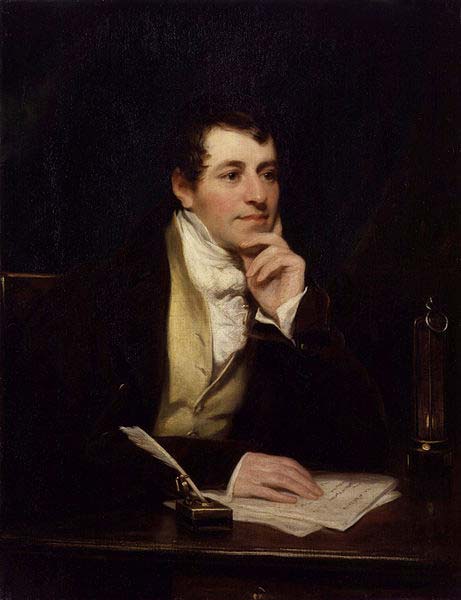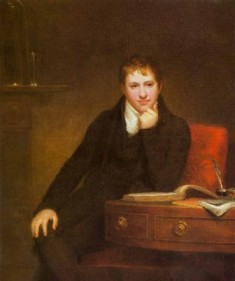| Humphry Davy | |
|---|---|
 |
|
| Chemist & Inventor | |
| Specialty | Chemistry |
| Born | Dec. 17, 1778 Penzance, Cornwall, England |
| Died | May 29, 1829 (at age 50) Geneva, Switzerland |
| Nationality | English |
Sir Humphry Davy was a popular English chemist and inventor. He is best remembered for his discoveries of several alkali and other alkaline earth metals. He is also famous for his contributions to the discoveries of chlorine and iodine elemental nature.
Early Life
Humphry was born on December 17, 1778, at Penzance in Cornwall. His father was a wood carver. As a young boy, Humphry was naturally gifted and very sharp; he could write impressive fiction and poetry. At only 16 years old, his father died. After the death of his father, he met Gregory Watt, the son of a famous inventor. The two became great friends and this strong relationship had a very important influence on Humphry’s career.
Humphry as a Poet
A lot has been said about Davy as a poet. His first production that has been discovered dates back to 1795. This work is entitled The sons of Genius. More poems were produced during the following years. Humphry Davy was also a great painter and three of his paintings dated about circa 1796 have been donated to Penlee House museum at Penzance. Humphry abandoned poetry for the sciences at the age of 17.
Davies Gilbert accidentally saw Humphry in Penzance; he was carelessly swinging on the half-gate of Dr. Borlase’s house. Davies was very interested in the young Humphry’s talk and offered to let him use his library. This is where Humphry was introduced to Dr. Edwards, a chemical lecturer at St. Bartholomew Hospital School. Edwards allowed Humphry Davis to use his apparatus in the laboratory for his research and studies.
Pneumatic Institution
Dr. Thomas Beddoes, who was a great English physician and writer, founded the Pneumatic Institution in Bristol. In 1756, Humphry became his associate. This institution was established for the purpose of investigating the medical powers of factitious gases and airs. Humphry was made the superintendence of a series of experiments.
During his stay in Bristol, he formed close relationship with the Earl of Durham, Gregory Watt, Samuel Coleridge, James Watt and Robert Southey. All of them became regular users of nitrous oxide, also known as laughing gas, with Davy becoming an addict.
Working with Nitrous Gas

Nitrous oxide was first was initially synthesized by Joseph Priestley who was a natural philosopher in the late 1700s. Joseph called this gas phlogisticated nitrous air and he published this discovery in 1775. In his book, he described how to produce this gas by heating iron filings dampened with nitric acid.
Years later, Humphry decided to research further on this gas. James Watt decided to build a gas chamber for Humphry to perform his experiments on nitrous gas. At first, Davy considered using this gas an anesthetic. However, anesthetics were not used in medicine until many years later after Humphry’s death.
In his experiments, Davy ran a great risk; the respiration of nitric oxide may have caused severe damage of the mucous membrane. Humphry’s last years in the institution were spent partially in experimentation.
Humphry’s Other Achievements
In 1801, Humphry Davy delivered his very first lecture at the Royal Institution. After this lecture, he instantly became a very popular person in the institution. His time as a lecturer was full of great success. During his second lecture at the Royal Society in 1807, he made public his great achievement – the decomposition by galvanism of the fixed alkali.
Davy actually performed a demonstration to show that alkali are just metallic oxides. All these discoveries are said to be the most important contribution made to the Philosophical Transactions of the Royal Society since Isaac Newton.
In 1774, chlorine was discovered by a Swedish scientist named Carl Scheele. This chemist mistakenly thought the gas contained oxygen. In 1810, Humphry gave chlorine its current name. He insisted that it was actually an element.
Davy’s Publications
Davy wrote many books and some of them include Element of Chemical Philosophy, published in 1812, Consolations in Travel, published in 1830, and Elements of Agricultural Chemistry, published in 1813.
Legacy and Death
In 1912, Humphry Davy was knighted. After this, he married a very rich widow named Jane Apreece. Davy was also made a baronet in 1818 for his outstanding contributions to his home country and mankind. This was especially after he invented the safety lamp. In 1829, he was promoted to be the president of the Royal Society where he performed his duties for seven years. In 1827, his health started to decline and he was forced to resign. Humphry died on May 29, 1829.